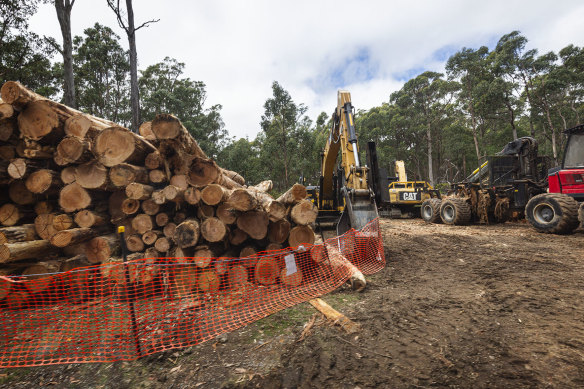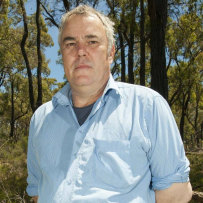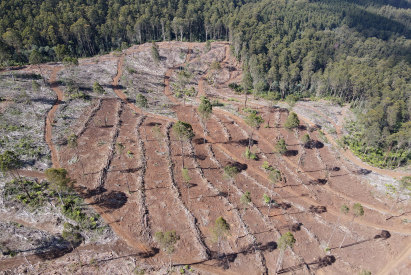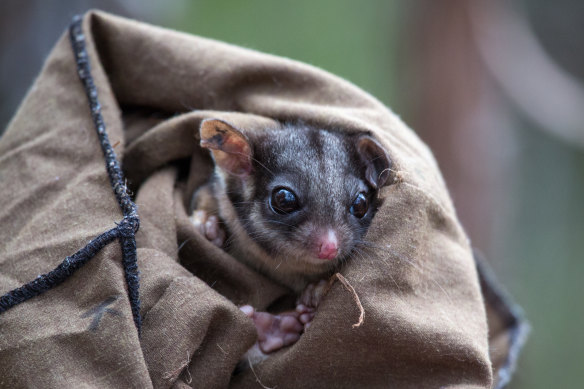This was published 5 months ago
Why native forest harvesting is the ‘zombie’ industry that won’t die
By Bianca Hall
When the Victorian government announced it would stop logging its own native timber for commercial purposes, environment groups celebrated.
Protecting the state’s Crown land forests, they declared, would safeguard threatened wildlife, secure clean drinking water supplies and help Victoria reduce its greenhouse emissions.
Commercial logging officially ended on January 1 this year, but those celebrations now seem premature. The timber mills that haven’t shut their doors continue to process native hardwood timbers – now fed by private landholders felling forests on their properties, and the government’s 300 per cent expansion of bushfire “fuel reduction” targets.
Much of the timber felled by government-employed or contracted workers in state forests and national parks will be sold as firewood.
Under an expanded “strategic fuel break” program quietly unveiled earlier this year, the Department of Energy, Environment and Climate Action (DEECA) plans to construct 6000 kilometres of fire break tracks, up to 40 metres wide, through state forests and national parks by 2030 – up from a previous target of 1447 kilometres. Bushfire mitigation works do not require approval under federal environment laws.
The department has also vowed to remove “hazardous” trees, particularly in heavily forested areas, and extract logs “and other forest residues” for transport.

Logs piled high for a Department of Energy, Environment and Climate Action “debris removal” operation in the Wombat State Forest in April.Credit: Chris Taylor
Environment Minister Steve Dimopoulos told The Guardian in July that, in 2023–24, some 91 per cent of timber removed after storms ended up as firewood “because it’s not suitable for anything else”.
Professor David Lindenmayer, one of the world’s most cited ecologists, said he was yet to see evidence that the government’s fuel breaks program would reduce bushfire risks.
“There’s good evidence that fires will spot somewhere between 500 metres and 13.9 kilometres. Are we seriously thinking that a fire break 40 metres wide is really going to do much?”
Meanwhile, satellite images show the scale of private logging operations, several of which are owned by or linked to timber sawmills.
Unlike logging on Crown land, logging on private properties usually requires only a planning permit from rural and regional councils, which are often underresourced and ill-equipped to assess the ecological impacts of native forest logging.
Environment groups say logging is now taking place without proper planning or oversight, leaving threatened species at risk. They have urged the Victorian government to immediately apply its commitment to end commercial native logging on Crown land to private land.
At one private logging site in the Yarra Ranges, foresters continue to clear-fell mountain ash metres from three colonies of critically endangered Leadbeater’s possums. The director of the logging operation, Gary Featherston, said the operation’s permit was granted before the colony was discovered, and the logging operation was legal.

Victorian National Parks Association Matt Ruchel says logging on private land needs to be better regulated.
Victorian National Parks Association (VNPA) chief executive Matt Ruchel said private logging had escalated after the commercial ban on logging in Victorian native forests took effect.
“It’s escalating quickly,” he said. “It seems to be driven by a long-term strategy to maintain a timber-harvesting supply, with a view to hoping that the industry returns ... I think private land logging is seen by the industry as a way of filling the holes.”
Announcing the end of native logging on public land last year, then-premier Daniel Andrews cited a lack of native timber supply, climate change, and rolling legal challenges launched by environmental activists.
“Native forestry has been hit with increasingly severe bushfires, prolonged legal action and court decisions,” he said in a statement.
“There are no alternative timber supply sources available domestically or internationally which can offset the current disruptions to supply to Victorian mills.”
According to the VNPA, Environmental Justice Australia, Professor Lindenmayer and Dr Chris Taylor from the Australian National University, alternative supplies have not been difficult to find.
Nestled among the Great Dividing Range in the Yarra Ranges is Mt Horsfall, which is covered in dense mountain ash forest and home to three known Leadbeater’s possum colonies. One of the rolling peaks is now marred by a vast open scar, which is visible from satellite imagery.
Mount Horsfall’s scars visible from above

The denuded landscape at Mt Horsfall, after private logging operations over the past 18 months.
Property records show Powelltown Sawmills took possession of the 120-hectare site, which borders the Yarra Ranges National Park on one side and state forest on another, in February 2023. At the time, aerial images show the block was all but pristine. Satellite images regularly captured since then show the dense native forest becoming increasingly denuded.
Mt Horsfall is one of seven properties managed as a group by Forest Strategy, which has Forest Stewardship Council (FSC) certification for the bundle of sites.
An FSC audit report obtained by this masthead shows the mountain ash at Mt Horsfall is destined to be sold as logs, firewood, sawn timber, sawdust, and woodchips.
“The three [Leadbeater’s possum] colonies ... were discovered just after the planning permit was issued, so the planning permit doesn’t consider them.”
Forest Strategy director Gary Featherston said the private logging operations at Mt Horsfall were lawful and covered by a planning permit and FSC certification.
But the nature and extent of the logging on Mt Horsfall have been the subject of bitter dispute.
The Victorian National Parks Association has lodged multiple complaints with the Office of the Conservation Regulator, alleging loggers have destroyed known threatened species habitats, failed to observe the 200-metre exclusion zones around known Leadbeater’s possum colonies, and their logging has encroached into the adjacent Noojee State Forest.
Taylor and Lindenmayer have also lodged complaints about the logging, which is taking place less than one kilometre from a parcel of mountain ash that has been the subject of long-term monitoring by teams of ANU academics.

Critically endangered Leadbeater’s possum colonies lie near the logging sites on Mt Horsfall.Credit: Zoos Victoria
Featherston said the mapping relied upon by the complainants was incorrect and that the Office of the Conservation Regulator had made no findings against his operations.
As for threats to nearby colonies of Leadbeater’s possums – the tiny and critically endangered marsupial that is also Victoria’s faunal emblem – Featherston said: “What we’ve done is certainly legal”.
“The three [Leadbeater’s possum] colonies that are near the edge of the property were discovered just after the planning permit [for logging] was issued, so the planning permit doesn’t consider them ... they’re close to the area that’s already harvested.”
‘We just want to farm it’
Last year, forester John McConachy, whose family have been timber workers for almost 70 years, applied to East Gippsland Shire Council for a permit to log 51 hectares of native bush on his Cabbage Tree Creek block. The land is covered with trees, including white stringybark, messmate, Gippsland peppermint, and mountain grey gums.
McConachy, who has owned the property for 15 years, said he had no intention of “decimating” it.
“We put up a process called retention harvesting so that any of the older trees or habitat trees, we make a bigger perimeter around them,” he said. “I don’t want to destroy the whole forest; we just want to farm it … farming trees instead of grass.”
Councillors narrowly voted to refer McConachy’s application to Planning Minister Sonia Kilkenny, seeking clarity on the government’s position on native forest logging on private land (not including plantations).
Cr Mendy Urie told the meeting: “I think, unfortunately, it seems there’s a bit of a policy void around native forest logging on private property, so we’re without the normal guidance and structures that we could rely on to get a good result.”
McConachy – who said he already had the green light from DEECA, the Department of Transport and the East Gippsland Shire Council’s planning officer – expressed frustration with the process.
His frustration highlights the legislative opaqueness that now characterises native forest logging in Victoria.
“What do I do with it if this planning application is disallowed – what value is that property to me?” he said. “Is the government prepared to buy that property back from us? It’s not a lot of value to us. We can’t do much with it. It’s forest.”
Conservationists say after the Victorian government brought forward the end of commercial timber harvesting to January 1, the handful of timber mills that remain are being fed with trees felled on private properties.
Victorian Forest Products Association Deb Kerr told the Gippsland Times in January it wasn’t clear how many sawmills had shut down after the state’s commercial logging ban, but flagged the native hardwood industry would “diversify”.
“A small number of processors will continue processing the native timbers that consumers love, sourcing this wood from private sources in Victoria, from other states and from overseas,” Kerr said.
Kerr stepped down as the association’s chief executive in March and finished her position in June. She is now the grants and sponsorship lead at Healthy Forests Foundation, an organisation led by former VicForests chief executive Monique Dawson that some environmentalists have accused of “greenwashing on steroids”.
The new chief executive of the VFPA, Andrew White, referred questions to the Department of Energy, Environment and Climate Action. DEECA has been contacted for comment.
The VNPA says Victoria is the most cleared state in the country, with up to 80 per cent of private land having already been cleared. It is investigating at least six other private properties where native forest logging is under way, or planned.
Get to the heart of what’s happening with climate change and the environment. Sign up for our fortnightly Environment newsletter.